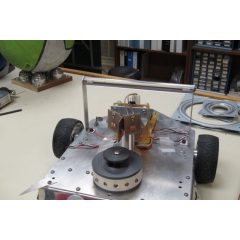Categories
- animatronics (12)
- apple (11)
- arduino (179)
- art (41)
- articles (121)
- artificial intelligence (11)
- automation (421)
- avr (205)
- bitcoin (3)
- breadboard (9)
- cameras (57)
- cars (26)
- cell phones (28)
- clothing mods (21)
- console mods (26)
- dangerous (94)
- desktop mods (24)
- embedded (5)
- flying things (54)
- fpga (22)
- gaming creations (108)
- interface (225)
- internet (17)
- laptop mods (6)
- lasers (22)
- linux (7)
- magnetic (3)
- medical (12)
- microcontrollers (51)
- misc projects (152)
- msp (12)
- music (124)
- pic (90)
- projects (23)
- pyroedu (76)
- raspberry pi (26)
- robots (312)
- security (36)
- sensors (307)
- software (200)
- solar (19)
- stamp (9)
- tools (149)
- tutorials (98)
- Uncategorized (45)
- usb (44)
- wireless (256)
Sponsors


Posted November 24, 2013 by Chris
"All of the hardware and software is open (in the GPL sense), including parts lists, circuit board and chassis designs, and software. With a stated goal to produce sub-€100 robots, I’d really like to see this take off. Combined with a wireless power surface, a micro-robot in perpetual motion would make a great desk ornament!"

Posted November 21, 2013 by Chris
"For our final project, we re-engineered a remote control car to autonomously navigate through a track by detecting lanes and centering itself between them as well as detect objects in front of it and avoid collision. The RC car detects lanes through image input from a low-resolution camera mounted at its front. Using an IR distance sensor, the car determines when to stop accelerating once a certain distance between a forward object has been breached."

Posted November 12, 2013 by Chris
"To the RC car I removed all the electronics except the motors and i installed 6 new AA 1,2V rechargeable NiMh 1900mAh batteries. I designed new electronics based on Arduino with a HC-05 Bluetooth module and two h-bridge ic’s. The SN754410 for steering motor and the L298N for forward/backward motor. For both ic’s i connected parallel the channels, 1 with 4 and 2 with 3."

Posted November 10, 2013 by Chris
"As a beacon, unmodulated white light sucks….So, what to do? After rejecting a few stupid ideas I finally got interested in using X-Band microwave signals as a beacon. Oh my. Sounds pretty intimidating huh. 10,000 mHz radio is black magic. Or is it?"

Posted November 4, 2013 by Chris
"N-Bot is an educational robotic platform developed at the NatalNet laboratory with the aim of making robots popular among students of all ages. N-Bot uses a simple, yet universal communication interface: the audio channel."

Posted October 8, 2013 by Chris
"The circuit was build with microcontroller ATmega8.
Here, I’m extending the same circuit to control the DC motor with IR remote control. The motor is fitted on a toy car wheels with gears, as shown in the figure above."

Posted October 7, 2013 by Chris
"The 2009 Robot Rally spotlighted all the flaws that result from a quick 3 week engineering and building project. Time saving shortcuts in code and hardware bit my butt several times. Failed edge detectors – Ouch! Failed beacon tracker … chomp! Ow! Line follower reversal – Arrrg! I’m happy to report I’ve investigated all the issues that cropped up and fixed them all."

Posted October 4, 2013 by Chris
"The objective of the Photovoltaic Martian Bug project is to create small autonomous robots. These robots will be powered by solar panels and intelligently react with their environment."

Posted September 30, 2013 by Chris
"The Haptic Creature has three degrees of freedom through which it communicates its emotional state: a pair of ears, which vary in stiffness; lungs, which simulate breathing; and a purr box, which renders a vibrotactile “purr”. The robot has an array of force sensors across its body to sense touch and an accelerometer to sense movement."

Posted September 16, 2013 by Chris
“This project started about 8 months ago in January 2010, when I saw that a surprising number of people were making ROVs at home. Though very few had footage of anything interesting, it certainly proved the concept was viable. I’ve always been fascinated and fearful of the ocean, so this seemed a great way to explore the depths without having to personally go where the sun doesn’t shine.”






